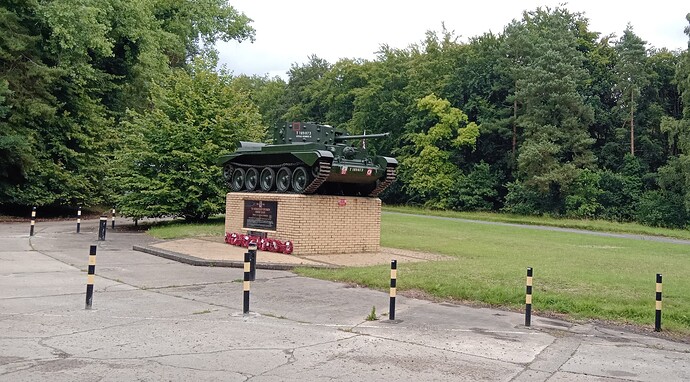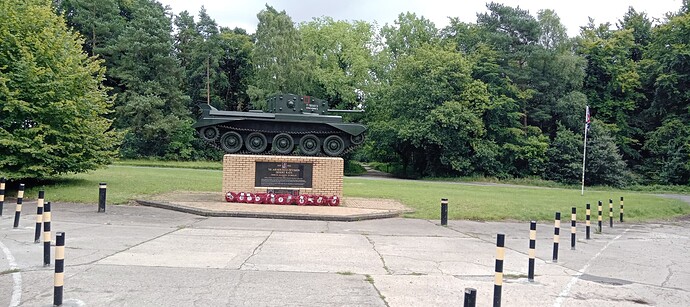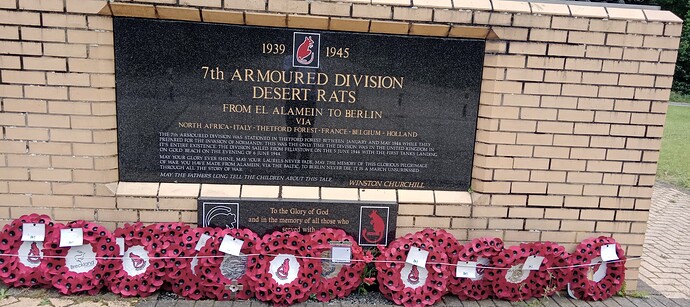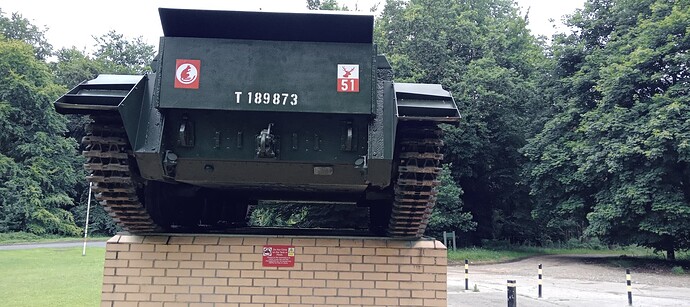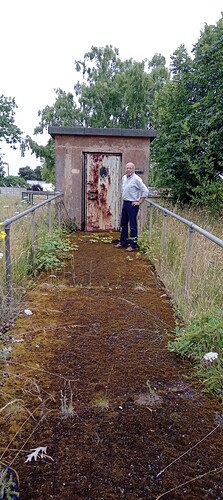As the weather improved we’d had a couple of days on the very pleasant beaches in the vicinity but Zero Alpha thought that a town might be worth a potter; a look at the map indicated that perhaps Thetford would fit the bill, so off we went. I had identified a museum which I erroneously thought was armour, en route. Getting to it took a lot of navigation and in the end it turned out to be a steam museum. Epic fail, and it had cost us an hour.
Plan C had factored in a couple of the so far, elusive Thor sites north of Thetford, and the 7th Armoured Division memorial in Thetford Forest. Time was beginning to run out so we aimed for the memorial. As you can see it consists of a Cromwell tank high on a plinth:
Whilst I’m pretty sure the markings are accurate the paint is a post war Deep Bronze Green; this is a very resilient high gloss paint and I’m sure was chosen as the tank is out in all weathers; I suspect anything approaching SCC whatever would have long faded by now and look horrible. As it is, the monument I feel, is very impressive. Elements of the Division were actually billeted in the forest itself and a couple of hundred metres from the tank there is a trail showing how the soldiers lived and worked. For the uninitiated this is all prior to the invasion of Europe in 1944.
Now for the best bit of the whole holiday: Plan D – I’d had to bin the Thor site scheme – involved a visit to what had been the RAF Barnham nuclear weapon storage site around 20 miles away from the Cromwell. This sadly, is now an industrial site although I believe some parts are listed; after a bit of nosing around I came across what was obviously a blast wall, and Lo! And behold! A Blue Danube nuclear bomb (15 kt folks), conceivably not live! Brilliant. These days of course, nothing much escapes Google and a more comprehensive brief awaits those who wish it, but essentially the location was a highly classified site and closely guarded; and was used for the completion of the bombs (ie assembly the insertion of the fissile material) prior to delivery to the various V Bomber bases.
The Blue Danube was tested - that is the casing - at the Orford Ness site mentioned by Littorio in Part 1 of my holiday saga.
The plutonium was stored in small brick “hutches”; these are still in existence and although the one I investigated was full of builders’ material (what did I expect? A dull metal sphere guaranteed to make my teeth fall out and what’s left of my hair to vanish?) the site still seems to have most accessible. I understand that tours are given but the agency responsible was closed for the day by the time we got there.
Old bloke merely included for scale.
A surviving watchtower, which just goes to show that anything the East Germans can do, the RAF Regiment can match.
Again, the pics speak for themselves perhaps, but I found it all fascinating; whilst now full of extra sheds and industrial units, it doesn’t take much to squint a bit and imagine a busy, focused military base, hidden in the woods, complete with armed RAF regiment guards, dog patrols, watchtowers, bespoke transportation vehicles and those sinister “hutches”, or is that just me?
And one of the “Hutches”; again, fat old bloke merely for scale. You can just make out the combination lock on the door.
There was another such site in Lincolnshire at RAF Faldingworth.
Afternote: I’m now not sure about the insertion of the fissile material into the bomb prior to delivery; I think I’ve read somewhere that it had to be inserted in flight(!), but clearly I need to do some more research.
Probably only of interest to such Cold War fanatics as I, but depending on your level of interest, well worth a visit. The presence of a Blue Danube alone was sufficient for me. I am aware that there’s one at the War Museum at Duxford.
Suffice to say, we never did make the “potter” into Thetford; I do wish my wife wouldn’t look at me that way.
